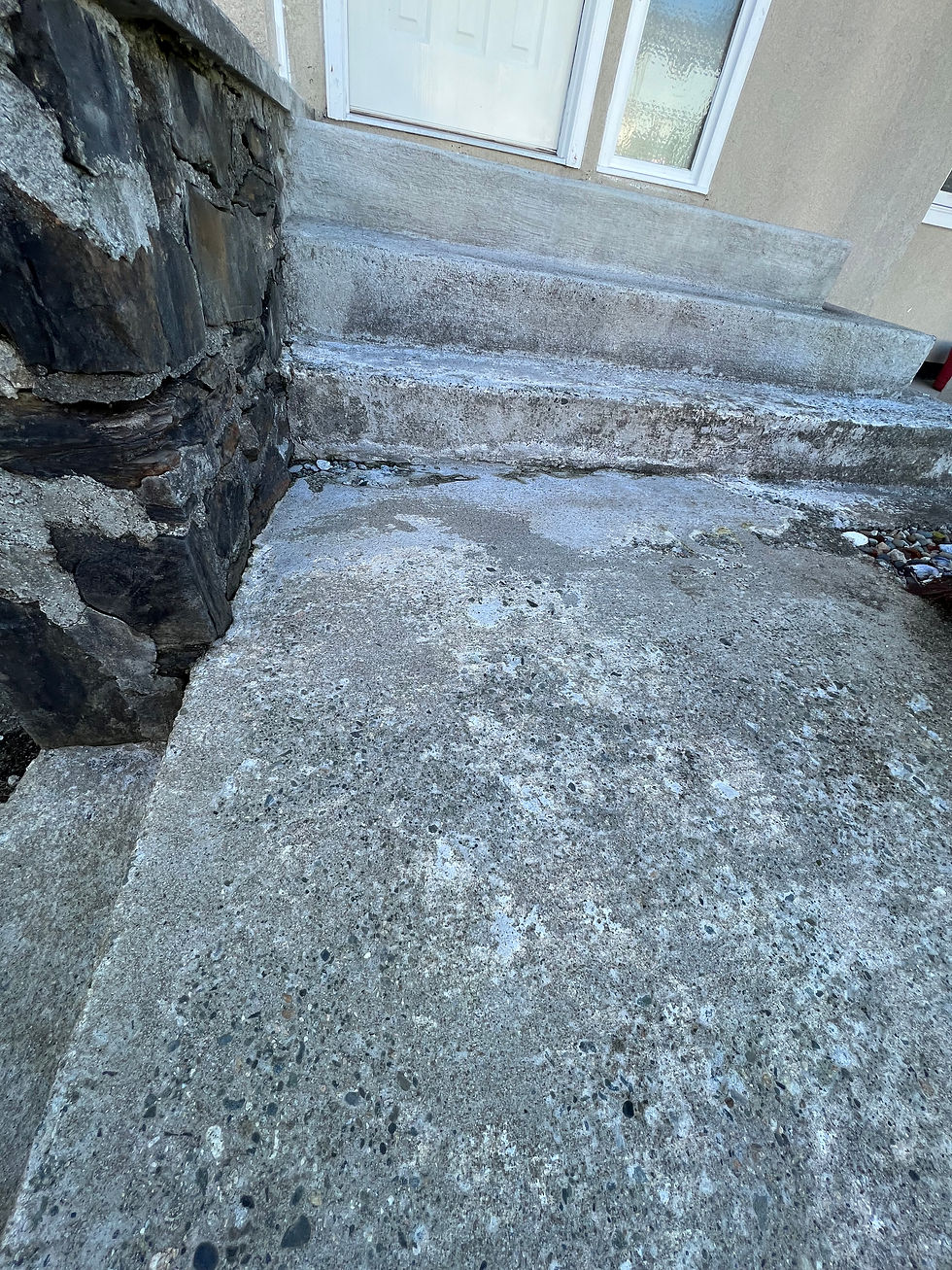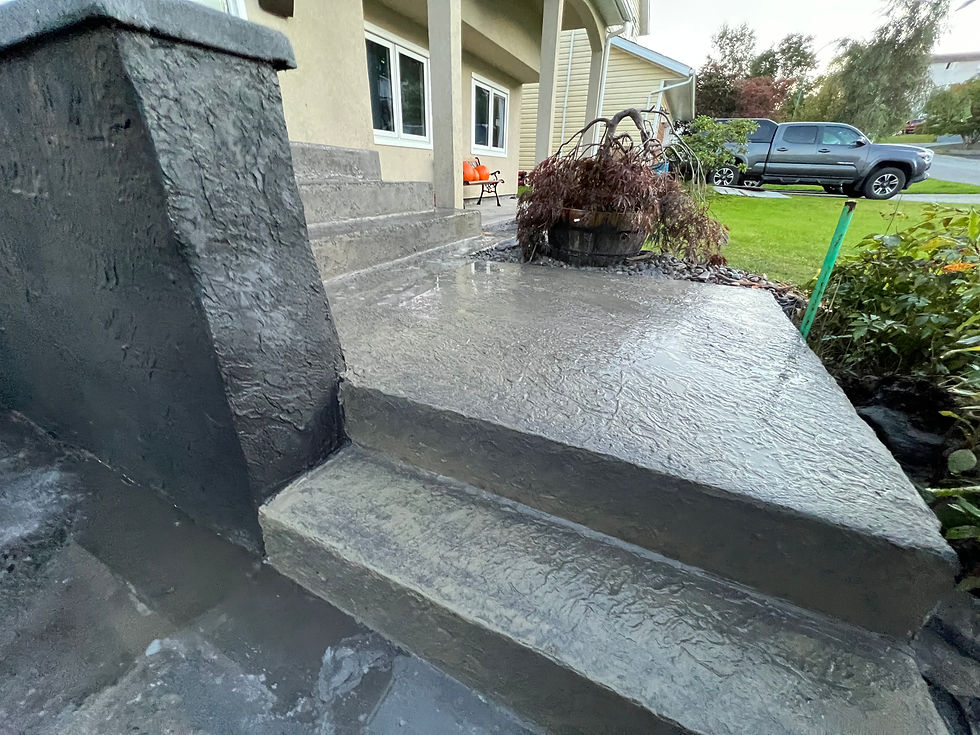Concrete Refinishing in Terrace, BC: When to Repair vs. Replace Your Floors
- James Walther
- May 5
- 6 min read
Concrete at a Crossroads
Concrete is tough—until it’s not. Maybe it’s a garage floor that’s seen one too many winters. Maybe it’s a patio beaten down by Terrace’s freeze-thaw cycles. Whatever the space, you’re standing on cracked, stained, or worn-out concrete, wondering: Should I try to fix this? Or rip it out and start over?
Here’s the good news: full concrete replacement isn’t always necessary. In fact, for many homes and businesses around Terrace, concrete refinishing is the smarter, faster, and far more cost-effective solution. But refinishing isn’t a magic wand. Sometimes it’s the right move—and sometimes replacement is the only real fix.
At Executive Surfaces, we help property owners figure that out every day. And in this post, we’ll walk you through how to tell the difference. By the end, you’ll know when it’s safe to save your slab—and when it’s time to start fresh.
What Concrete Refinishing Actually Means
Let’s clear something up right away: concrete refinishing doesn’t mean ripping out your slab and starting over. It means working with the concrete you’ve already got—grinding it, repairing it, resurfacing it, and protecting it so it looks good, performs better, and lasts a whole lot longer.
In Terrace, that could mean restoring a stained garage floor, smoothing out a rough shop slab, or bringing life back to a weathered patio. Whatever the case, the idea is the same: preserve what’s solid, fix what’s not, and make it functional again.
Here’s what concrete refinishing typically involves:
Mechanical grinding to remove surface damage and open up the concrete for bonding
Crack repair and patching where needed
Surface treatments, like sealers, densifiers, or epoxy coatings
Polishing or decorative overlays, if you want to take it from functional to flawless

It’s a flexible process that can be customized depending on the condition of the slab and how you plan to use the space. And compared to replacement? It’s cleaner, faster, and dramatically more affordable—if the slab is worth saving.
Signs You Can Save Your Concrete
So, how do you know if your slab is a good candidate for refinishing? The key is knowing what counts as cosmetic damage versus structural failure. If the bones of the slab are solid, refinishing can give you a fresh, durable surface without the expense and mess of a total replacement.
Here are the most common signs that concrete refinishing could be the right move:
1. Surface Cracks, Not Deep Fractures
Hairline cracks or shallow spider-webbing are normal as concrete ages—especially with temperature swings like we get in Terrace. If they’re not shifting, separating, or widening over time, they’re likely just surface-level and can be filled or blended during the refinishing process.
2. Cosmetic Staining or Discoloration
Oil stains, rust marks, or just decades of grime? That’s no reason to rip out an entire slab. Mechanical grinding or a surface overlay can erase years of wear and restore the floor’s appearance.
3. Minor Pitting or Texture Issues
Pitted areas and surface roughness are common in older shop floors or patios. As long as the damage isn’t deep or widespread, these areas can be patched, leveled, and sealed during refinishing.
4. Concrete is Still Structurally Stable
If the slab is flat, not sinking, and doesn’t feel hollow or soft underfoot, you’re in great shape. That means the underlying structure is still doing its job—you just need to clean up the top layer.
5. You’re Using the Space Normally
If your garage isn’t housing heavy machinery or your patio isn’t handling forklift traffic, a refinished surface is likely more than enough for everyday wear and tear.
In many Terrace homes and small businesses, the concrete underneath still has years of life left—even if it looks rough on the surface. If you’re seeing any of the signs above, there’s a good chance refinishing is the smarter move.


Signs It’s Time to Replace Instead
As much as we’d love to save every slab in Terrace, the truth is: some concrete just can’t be salvaged. Refinishing can only do so much. If the foundation is failing, patching the surface is like painting over rot—it might look okay for a bit, but the problems will come back fast, and worse.
Here are the signs that your concrete needs more than a facelift:
1. Major Structural Cracks or Separation
We’re talking deep, wide cracks—especially ones that are growing, shifting, or buckling. If you can feel elevation changes or movement between slabs, that’s a clear sign of structural failure. Refinishing won't fix that—it'll just mask it temporarily.
2. Sinking or Heaving Slabs
If parts of your floor are lower than others, or if one corner is rising due to frost heave or poor subgrade, refinishing isn’t the answer. These issues come from below the surface and require full removal and re-pour to correct.
3. Severe Surface Erosion or Scaling
If the top layer of your slab is flaking off in large areas, especially from years of road salt or freeze-thaw damage, the surface might be too far gone to bond to. You need a clean, solid base for refinishing to work—and in cases like this, that base is gone.
4. Moisture Issues From Beneath
If water is seeping up through the slab—common in poorly drained areas—no sealer or overlay is going to stop it long-term. That moisture pressure will eventually break down coatings, adhesives, or decorative finishes. A new slab with proper vapor control might be your only real fix.
The takeaway: If your concrete has any of these issues, refinishing won’t save it—it’ll just delay the inevitable. And when it comes to long-term value? Delaying can cost more than doing it right the first time.
That’s why Executive Surfaces always checks before quoting a refinishing job. Let’s talk about that next.
Why Executive Surfaces Always Starts With a Site Evaluation
In this line of work, guessing is a recipe for disaster. Every concrete slab is different—especially in a place like Terrace, where moisture levels, soil movement, and freeze-thaw cycles can wreak havoc under the surface. That’s why Executive Surfaces never gives one-size-fits-all answers when it comes to refinishing.
We always start with a proper on-site evaluation—and here’s why that matters.
1. You Can’t Judge a Slab by Surface Damage Alone
What looks like a minor crack might actually be a sign of slab movement. What looks like cosmetic spalling could be the beginning of deeper deterioration. That’s why we don’t just quote based on a photo or a quick phone call. We walk the site, check the concrete condition, and see how the slab is performing overall.
2. We Test, Don’t Guess
When needed, we use:
Moisture meters to check for vapor transmission
Surface hardness tools to gauge how well refinishing products will bond
Straightedges and levels to check for settling or heaving
That kind of testing doesn’t take long—but it makes all the difference when it comes to doing the job right.
3. We Give You Real Answers, Not Sales Pitches
If your concrete can be refinished, we’ll tell you—and we’ll explain exactly what process we recommend and why. And if your slab isn’t worth saving? We’ll be honest about that too, even if it means not booking the job.
That’s just how we work. We’re not here to sell you the most expensive option. We’re here to get it done right—the first time.
Choose Smart, Not Expensive
Concrete problems can be intimidating—especially when the surface starts cracking, flaking, or looking downright worn out. And around Terrace, Prince Rupert, and Kitimat, where freeze-thaw cycles and damp weather take a toll on every slab, it’s easy to assume replacement is your only option.
But here’s the good news: many damaged concrete floors can be refinished instead of replaced. If the structure is sound, refinishing can bring your floor back to life—saving you thousands of dollars, days of downtime, and a lot of unnecessary demolition.
That said, refinishing isn’t always the answer. If the slab’s too far gone, it’s better to know now than after patching problems that won’t stay fixed.
That’s why Executive Surfaces starts with a real, honest evaluation—no sales tactics, no guesswork. Just experienced advice from a local contractor who understands what concrete in the Northwest actually deals with.
Serving Terrace, Prince Rupert, and Kitimat
If you’re dealing with rough concrete and wondering whether it’s time to repair or replace, let’s take a proper look.
Call James at Executive Surfaces today at (250) 975-1056 or fill out our contact form to schedule your free site evaluation. We’ll help you make the smart choice—based on facts, not sales pressure.

Comments